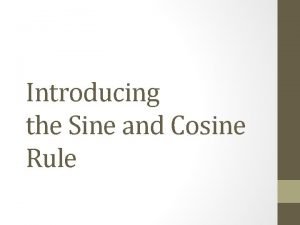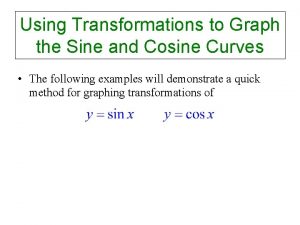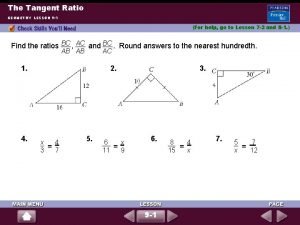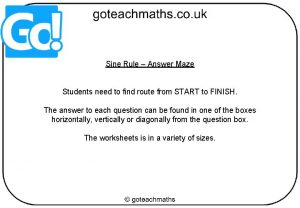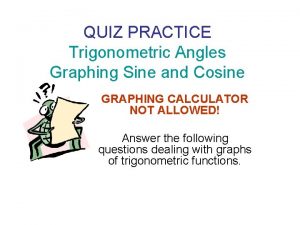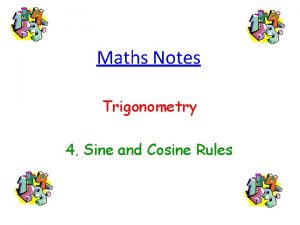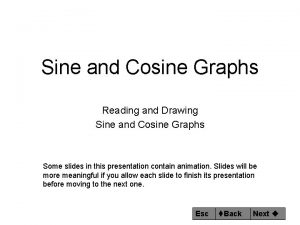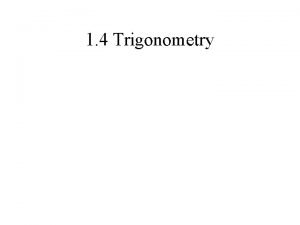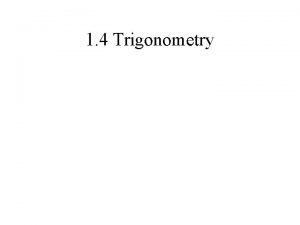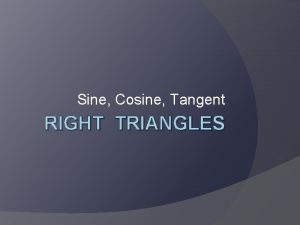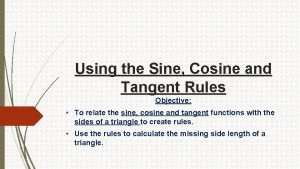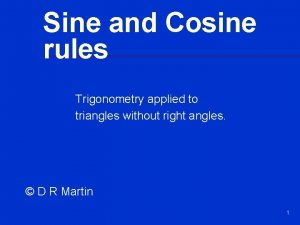15 G 15 J Sine and Cosine Rules








- Slides: 8

15 G – 15 J Sine and Cosine Rules Unit 6: Geometry and Trigonometry 1 15 G, 15 H, 15 I, 15 J 2/16/2022 11: 23 AM

Terminology Cop y oblique triangles: non-right triangles (acute or obtuse) triangle congruence method: usually used to prove two triangles have the same shape and size; can also be used to show that when you construct a triangle with three given measures, you can only construct one unique shape Methods “Non-Methods” SAS 2 SSS SSA SAS AAA SSS 15 G, 15 H, 15 I, 15 J ASA AAS SSA/SAS (mismatched) 2/16/2022 11: 23 AM

Congruence Methods SSS AAS SAS 3 15 G, 15 H, 15 I, 15 J 2/16/2022 11: 23 AM

Cop y Oblique Triangle Rules sides a, b, and c are across from angles A, B, and C respectively Sine Rule AAS, ASA, SSA: none, or two unique triangles with the given measures if the side length opposite the given angle is less than the other length, construct an isosceles triangle and check for the “ambiguous case” (second triangle) by comparing angles 4 15 G, 15 H, 15 I, 15 J 2/16/2022 11: 23 AM

Cop y SSA and the Ambiguous Case A = 60°, a = 10, b = 16 not possible to construct (not particular to SSA) A = 25°, a = 7, b = 11 two triangles 5 15 G, 15 H, 15 I, 15 J 2/16/2022 11: 23 AM

Cop y Oblique Triangle Rules Cosine Rule SAS, SSS SAS: find remaining side first and then… (see SSS) SSS: use the cosine rule to find the largest angle; use either rule past that point The sine and cosine rules work for right triangles but they are less efficient than using right triangle trigonometry (SOH CAH TOA). 6 15 G, 15 H, 15 I, 15 J 2/16/2022 11: 23 AM

Cop y Finding the Largest Angle A = 33°, b = 9, c = 13 Find the remaining side. Why is C the largest angle? How does using the sine rule instead of the cosine rule impact calculating C? 7 15 G, 15 H, 15 I, 15 J 2/16/2022 11: 23 AM

Domain and Range What impact does the range of the inverse trig functions have on finding angles in: right triangle trigonometry? SOH CAH TOA “oblique triangle” trigonometry? Sine Rule, Cosine Rule Therefore if you have an oblique triangle and you know all three side lengths, USE THE COSINE RULE TO FIND THE LARGEST ANGLE (across from the longest side). If the angle is obtuse, you’ve avoided the only potential issue. If it’s acute, there are no obtuse angles. After you have the largest angle measure, you can then use either rule. 8 15 G, 15 H, 15 I, 15 J 2/16/2022 11: 23 AM
